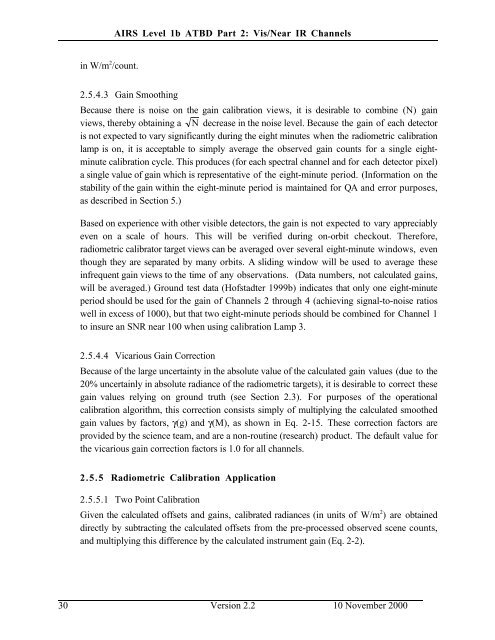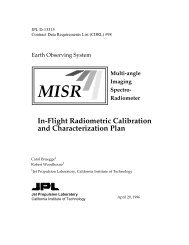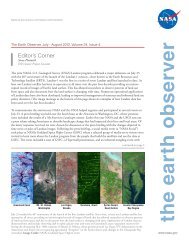AIRS Level 1B Visible/Near-Infrared Channels ATBD - NASA's Earth ...
AIRS Level 1B Visible/Near-Infrared Channels ATBD - NASA's Earth ...
AIRS Level 1B Visible/Near-Infrared Channels ATBD - NASA's Earth ...
You also want an ePaper? Increase the reach of your titles
YUMPU automatically turns print PDFs into web optimized ePapers that Google loves.
<strong>AIRS</strong> <strong>Level</strong> 1b <strong>ATBD</strong> Part 2: Vis/<strong>Near</strong> IR <strong>Channels</strong><br />
in W/m 2 /count.<br />
2.5.4.3 Gain Smoothing<br />
Because there is noise on the gain calibration views, it is desirable to combine (N) gain<br />
views, thereby obtaining a N decrease in the noise level. Because the gain of each detector<br />
is not expected to vary significantly during the eight minutes when the radiometric calibration<br />
lamp is on, it is acceptable to simply average the observed gain counts for a single eightminute<br />
calibration cycle. This produces (for each spectral channel and for each detector pixel)<br />
a single value of gain which is representative of the eight-minute period. (Information on the<br />
stability of the gain within the eight-minute period is maintained for QA and error purposes,<br />
as described in Section 5.)<br />
Based on experience with other visible detectors, the gain is not expected to vary appreciably<br />
even on a scale of hours. This will be verified during on-orbit checkout. Therefore,<br />
radiometric calibrator target views can be averaged over several eight-minute windows, even<br />
though they are separated by many orbits. A sliding window will be used to average these<br />
infrequent gain views to the time of any observations. (Data numbers, not calculated gains,<br />
will be averaged.) Ground test data (Hofstadter 1999b) indicates that only one eight-minute<br />
period should be used for the gain of <strong>Channels</strong> 2 through 4 (achieving signal-to-noise ratios<br />
well in excess of 1000), but that two eight-minute periods should be combined for Channel 1<br />
to insure an SNR near 100 when using calibration Lamp 3.<br />
2.5.4.4 Vicarious Gain Correction<br />
Because of the large uncertainty in the absolute value of the calculated gain values (due to the<br />
20% uncertainly in absolute radiance of the radiometric targets), it is desirable to correct these<br />
gain values relying on ground truth (see Section 2.3). For purposes of the operational<br />
calibration algorithm, this correction consists simply of multiplying the calculated smoothed<br />
gain values by factors, γ(g) and γ(M), as shown in Eq. 2-15. These correction factors are<br />
provided by the science team, and are a non-routine (research) product. The default value for<br />
the vicarious gain correction factors is 1.0 for all channels.<br />
2.5.5 Radiometric Calibration Application<br />
2.5.5.1 Two Point Calibration<br />
Given the calculated offsets and gains, calibrated radiances (in units of W/m 2 ) are obtained<br />
directly by subtracting the calculated offsets from the pre-processed observed scene counts,<br />
and multiplying this difference by the calculated instrument gain (Eq. 2-2).<br />
30 Version 2.2 10 November 2000







